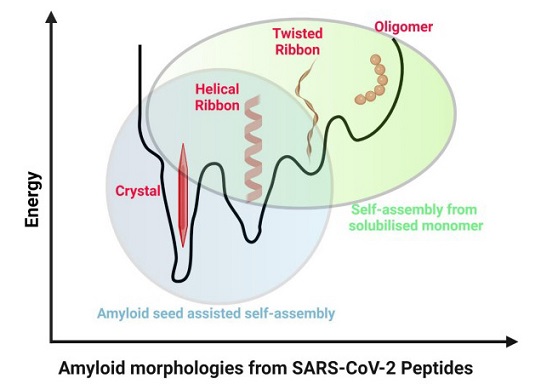SARS-CoV-2 Proteins Can Form Neurotoxic Amyloid Assemblies That Are Taken Up By Host Neurons
Nikhil Prasad Fact checked by:Thailand Medical News May 21, 2024 10 months, 3 weeks, 2 days, 14 hours, 31 minutes ago
COVID-19 News: COVID-19, caused by the SARS-CoV-2 virus, has wreaked havoc globally, affecting various organs, including the brain. As the pandemic progressed, an increasing number of patients reported neurological symptoms, collectively known as neuro-COVID. These symptoms range from memory loss and cognitive issues to severe headaches and sensory disruptions like loss of smell and taste. Disturbingly, these symptoms often persist for months, a condition termed post-acute sequelae of COVID-19 (PASC) or long COVID.
Recent research has started to uncover the potential molecular origins of these neurological issues. A significant finding suggests that fragments of SARS-CoV-2 proteins can self-assemble into amyloid nanofibrils, which are known to be neurotoxic. This
COVID-19 News delves into groundbreaking research that furthers our understanding of how these protein fragments from SARS-CoV-2, particularly from Open Reading Frame 6 (ORF6) and ORF10, form neurotoxic amyloid assemblies and their effects on neuronal cells.
 Amyloid assemblies formed from SARS-CoV-2 peptides are highly polymorphic, and the presence of pre-formed aggregates in the starting material (seeds) can promote the formation of lower energy assemblies (‘amyloid seed assisted self-assembly’) compared to solutions prepared in the absence of seeds (‘self-assembly from solubilised monomer).
The Link Between Amyloids and Neuro-COVID
Amyloid assemblies formed from SARS-CoV-2 peptides are highly polymorphic, and the presence of pre-formed aggregates in the starting material (seeds) can promote the formation of lower energy assemblies (‘amyloid seed assisted self-assembly’) compared to solutions prepared in the absence of seeds (‘self-assembly from solubilised monomer).
The Link Between Amyloids and Neuro-COVID
Amyloids are protein aggregates with a specific structure, often associated with neurodegenerative diseases like Alzheimer’s and Parkinson’s. The possibility that SARS-CoV-2 proteins can form amyloids raises critical questions about their role in neuro-COVID and PASC. Prior studies identified two SARS-CoV-2 protein fragments - ILLIIM from ORF6 and RNYIAQVD from ORF10 - that form neurotoxic amyloid assemblies. This research explores how these fragments self-assemble into various polymorphic structures, their neurotoxicity, and their uptake by neuronal cells.
Methodology: Understanding Amyloid Formation
The researchers used a fluorinated solvent to solubilize the peptides, eliminating insoluble aggregates that can influence the formation and stability of amyloids. This process revealed that the assemblies formed were predominantly structures with higher free energies, such as ribbons and amorphous aggregates, which are less toxic to neurons compared to stable crystalline structures.
Using multiple analytical techniques, including Fourier-transform infrared spectroscopy (FT-IR) and circular dichroism (CD), the researchers confirmed that these peptide fragments predominantly form β-sheet-rich amyloid assemblies. Further imaging with atomic force microscopy (AFM) and transmission electron microscopy (TEM) provided detailed insights into the nanostructures formed.
Results: Formation and Characteristics of Amyloid A
ssemblies
The ILLIIM peptide primarily formed crystalline structures composed of closely packed protofilaments, while RNYIAQVD formed a mixture of twisted fibrils and oligomers. Interestingly, the absence of insoluble seeds led to a significant change in the polymorphic landscape of these assemblies, resulting in higher energy, less stable forms.
These less stable forms are particularly noteworthy because they suggest a potential explanation for the transient nature of neurological symptoms in COVID-19 compared to chronic neurodegenerative diseases. The presence of less stable amyloids might indicate that they are more easily cleared by the body, leading to less prolonged damage.
Cellular Uptake and Toxicity
One of the most striking findings of this research is the direct evidence of cellular uptake of viral amyloids by neuronal cells. Using a fluorescent dye that binds specifically to amyloids, the researchers observed that these assemblies were taken up by cells and localized in the cytoplasm. This uptake indicates that amyloid fibrils from SARS-CoV-2 proteins can cross cell membranes, potentially disrupting cellular functions.
MTT assays, which measure cell viability, revealed that these amyloid assemblies significantly reduced the viability of neuronal cells. This reduction in viability was more pronounced at higher concentrations of the peptides, aligning with the hypothesis that the stability of the amyloid assemblies plays a crucial role in their cytotoxic effects.
Implications for Neuro-COVID and Beyond
The formation of amyloids from SARS-CoV-2 proteins and their uptake by neuronal cells provide critical insights into the potential mechanisms behind neuro-COVID. The reduced stability of these assemblies, as observed in this study, offers a glimmer of hope that the neurological effects of COVID-19 might be more transient and reversible compared to those caused by more stable amyloids associated with neurodegenerative diseases.
Further studies are needed to explore the exact mechanisms by which these amyloids cause neurotoxicity and to investigate whether similar mechanisms are at play in other viral infections
Moreover, this research opens up new avenues for therapeutic interventions. Anti-amyloid therapies, such as monoclonal antibodies used in treating Alzheimer’s, could potentially be repurposed to target and disassemble these viral amyloids, providing relief from neuro-COVID symptoms and other viral-related neurological disorders.
Conclusion: A New Understanding of Neuro-COVID
This study sheds light on the complex relationship between SARS-CoV-2 proteins and neurotoxic amyloid assemblies, advancing our understanding of neuro-COVID. By demonstrating the formation, polymorphic behavior, and cellular uptake of these amyloids, the research highlights the importance of studying viral amyloids in the context of COVID-19 and PASC.
The findings underscore the need for continued research into the molecular mechanisms of neuro-COVID and the development of targeted therapies to mitigate its long-term effects. As we learn more about the interplay between viral infections and amyloid formation, we move closer to unraveling the mysteries of neuro-COVID and finding effective treatments for those affected.
The study findings were published in on a preprint server and are currently being peer reviewed.
https://www.biorxiv.org/content/10.1101/2024.05.16.594465v1
For the latest
COVID-19 News, keep on logging to Thailand Medical News.
Read Also:
https://www.thailandmedical.news/news/scientists-discover-an-amyloidogenic-fragment-in-sars-cov-2-envelope-protein-that-promotes-serum-amyloid-a-misfolding-and-fibrillization
https://www.thailandmedical.news/news/study-shows-that-sars-cov-2-can-bind-to-amyloid-beta-fibrils
https://www.thailandmedical.news/news/covid-19-news-sars-cov2-nsp3-triggers-cell-death-and-exacerbates-amyloid-beta-42-mediated-neurodegeneration
https://www.thailandmedical.news/news/study-shockingly-finds-that-cerebral-amyloid-angiopathy-caa-that-causes-brain-hemorrhage-risk-can-be-transmitted-through-blood-transfusions
https://www.thailandmedical.news/news/south-korean-physicians-warn-that-covid-19-infections-can-trigger-gastrointestinal-aa-amyloidosis
https://www.thailandmedical.news/news/french-neurologists-raise-alarm-about-covid-19-and-cerebral-amyloid-angiopathy
https://www.thailandmedical.news/news/breaking-news-researchers-find-that-covid-19-infections-and-even-covid-19-vaccines-can-induce-amyloidosis
https://www.thailandmedical.news/news/breaking-university-of-cincinnati-study-finds-that-alzheimer-s-disease-is-caused-by-low-levels-of-amyloid-beta-protein-and-not-by-amyloid-plaques
https://www.thailandmedical.news/news/study-uncovers-that-sars-cov-2-n-proteins-are-able-to-enter-stress-granules-and-cause-amyloid-aggregation,-leading-to-various-neurodegenerative-issues
https://www.thailandmedical.news/news/breaking-u-s-department-of-defense-study-finds-that-covid-19-infected-individuals-younger-than-60-years-are-developing-beta-amyloid-deposits
https://www.thailandmedical.news/news/read-study-shows-sars-cov-2-n-protein-interacts-with-host-s-synuclein-proteins,-promoting-accelerated-amyloid-formation-and-parkinson-s-disease
https://www.thailandmedical.news/news/breaking-sars-cov-2-contains-amyloidogenic-peptide-fragments-that-are-neurotoxic-to-human-hosts
https://www.thailandmedical.news/news/fenchol-a-phytochemical-found-in-basil-may-protect-against-alzheimer-s-disease-by-reducing-neurotoxic-amyloid-beta-in-the-brain
https://www.thailandmedical.news/news/breaking-university-of-oklahoma-study-indicates-that-sars-cov-2-might-cause-serum-amyloid-a-saa-amyloidosis-and-even-alzheimer-ultimately
https://www.thailandmedical.news/news/coronavirus-news-study-finds-that-serum-amyloid-a-saa-linked-to-covid-19-inflammation-and-disease-severity-
https://www.thailandmedical.news/news/neurodegeneration-and-amyloid-accumulation-can-be-predicted-by-objective-subtle-cognitive-difficulties
https://www.thailandmedical.news/news/discovery-of-amyloid-precursor-protein-that-modulates-neuronal-signal-transmission-may-lead-to-cure-for-alzheimer.
